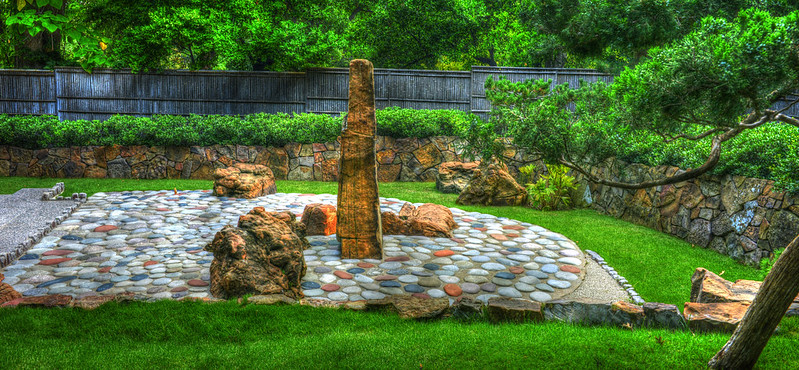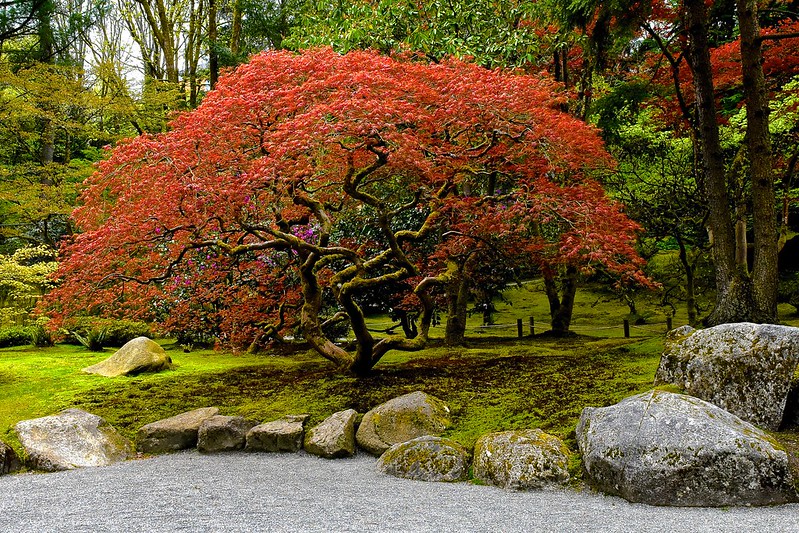How to Create a Backyard Japanese Zen Garden
BY EMALEY BAXTER | APRIL 30TH, 2019 | LAWN CAREToday’s hectic society has people looking for ways to simplify their daily lives. Some try to achieve this simplicity by downsizing their homes, cars, and lifestyles. For those that love to garden, be outdoors, or just enjoy a relaxing view while looking out the kitchen window, consider creating a Japanese inspired Garden in your very own backyard.

First Things First: What is a Japanese Zen Garden?
Traditional Japanese gardens (also called Zen Gardens) have always been intended to be spaces of meditation and reflection. Deeply connected to the tea ceremony, they originally began as a space made for Japan’s rulers and royalty, and have transformed over time into a way of life and deep-rooted into Japan’s culture. For many, there is something profound and calming about Asian design whether it is in art, architecture, or fashion. Perhaps it is the influence of the regions’ philosophical outlook on life or the value in leading a simple lifestyle that is deeply connected with nature of the region that has shaped style and design principles for several centuries. Either way, traditional landscape design done in the style of a ‘Japanese’ Garden can create a unique calming oasis in any backyard setting.
It is good to not that if your goal is to create a true Japanese garden you should be prepared to do a little research before you begin as it will take some self education to stay loyal to the culture of these traditional creations. At first glance, it could be tempting to utilize many cliché ideas of what the Japanese Zen garden should look like, many of which actually are preconceived notions coming from Chinese design and culture. Additions such as red hanging flowers and bridges covering small streams are all actually derived from Chinese traditions and often mistaken for Japanese garden design. While each and every attempt at this type of landscape is going to be slightly different depending on who is creating it, the theory behind the garden should be consistent — Creating your own haven of simplicity and zen.
Elements of a Japanese Zen Garden
Some basics of desiging a Japanese Zen Garden to consider:
- Pay mindful attention to pathways, their direction, the views they lead to, and the materials used
- There is value in a simplistic, understated design
- Use natural elements only
- Create views through windows/trees, under bridges
- Incorporate representations of basic elements (water, rocks, fire)
The basics of a Japanese Zen Garden, expanded upon:
1. Walkways should be designed to encourage contemplation.
Many Japanese gardens have paths that meander through space, crisscrossing streambeds, either symbolic or flowing with real water, and designed to guide a visitor on a meditative walk. To get the same effect of this thought-provoking walk but on a smaller, backyard scale, try to incorporate a walkway made up of stepping stones. The act of having to step from stone to stone will slow your way through the garden and encourage you to be present in the journey and experience the natural environment you have created elsewhere. Other design elements linked to pathways, such as courtyards, planting beds, and other garden elements should be laid out to promote balance in the landscape. Unlike classical European gardens that favor symmetry, Japanese gardens often achieve balance through asymmetry. For example, if a large boulder is placed on one side of a pathway, a tree is often placed on the other to promote the balance of form.

2. Representation of water should be bountiful.
A fundamental element essential to all life and a unifying characteristic across cultures, water, or the illusion of it, is often a celebrated feature in Japanese gardens and has been proven to have a soothing effect in landscape design. To get the look in your own backyard, pick a shady spot if possible and dig a shallow depression to act as a dry streambed. Fill this area with dark gravel and nestle rounded fieldstones along the banks and fill in with ferns and tufts of various sedges (Carex). You now have low maintenance dry creek bed.
3. A representation of a mountain.
Japanese gardens often have one or more large stones or boulders representing mountains in the landscape and anchoring the design. Boulders look more natural, and more like miniature mountains when they are partially buried and have plants nestled around the base, or small shrubs placed nearby to relate to the size and scale of the stone.
4. Rock gardens or Zen gardens.
Originally designed as meditation gardens, dry landscapes made up of a composition of rocks, moss and small trees are also common elements of Japanese gardens. The pale sand or fine gravel spread to cover the ground represents water and is often raked into ripples. Even on a small scale in a home garden, these stylized landscapes can be very peaceful to gaze upon.

5. How to plan your softscaping for your Japanese Zen Garden.
As is true with most landscape design, it can be easy to feel overwhelmed with either joy or dread at the vast options of plants to choose for your new landscape design. But when designing a Japanese or Zen Garden do not feel pressured to incorporate a large variety of plants into the garden. In fact, by sticking with two or three essential mossy or low growing ornamental grasses, you will not only have an easy-to-maintain garden, but you will be more likely to achieve the necessary step of keeping everything simple. A garden that is crafted with the simplicity of design as the driving focus quickly allows a visitor’s mind to unclutter itself. In fact, a true replica garden will not contain flashy or bright colors. Instead, monochromatic green is preferable and used as a primary palette.
When it comes to flowers, they are not out of the question. It’s just important to recognize their role in the garden and your journey towards Zen. Flowers can be colorful, but not so colorful as to be distracting. Above all, the Japanese traditions calls for flowers to work towards highlighting the green that acts as the balancing color of the garden.
In addition, the garden arrangement is going to be key. The thought process behind a garden such as this is that every little detail is a symbol. The entirety of the landscape is meant to work towards creating Zen, which means everything serves a purpose. But of course, rules were meant to be broken, and if you are creating a space of your own to relax and meditate in, be sure to make some personal additions that help you on your way to your own piece of inner bliss.
6. Japanese maples are a must.
A discussion about Japanese gardens would not be complete without mentioning the beauty of the graceful branch formations and delicate leaves of Acer palmatum, or the Japanese Maple. They have long been cherished by both Japanese gardeners and those that value the uniqueness of the tree worldwide. All varieties of the trees stay relatively small, 5 to 25 feet, smaller with pruning, making them beautiful additions to small backyards, near entrances, or in courtyard gardens. Today, buyers can choose from varieties with leaf colors ranging from chartreuse to plum and various forms of leaves from wide palm shapes to long skinny, serrated leaves.

Elements that are best NOT included in a Japanese Zen Garden
We have now discussed the basics of design for a Japanese garden. However, it is true that you own the landscape and can do anything you want with the space so as to best serve your own needs. Yet as we have already discussed, there are simple guidelines to follow for making the garden more attractive and enjoyable to you and anyone who experiences it. The following rules for what not to do are commonsense principles as you get involved in the design process of a traditional Japanese garden.
Items that should be left out of any backyard Japanese Zen Garden
1. Painted wood
Resist the temptation to paint wooden benches, fences, gates, arbors, or other garden structures. Instead, use a natural colored stain them as needed or allow them to weather naturally. An exception to this rule would be a brightly colored bridge that serves as a focal point. These are often painted a red-orange and have a shiny lacquer finish.
2. Lots of color (believe it or not)
Too much color can literally take over the landscape and upset the desired natural flow. Use bright colors sparingly, and specifically, more as an accent.
3. Non-natural materials (e.g. plastic, glass, concrete)
If you wish to have art or decorations in your Japanese garden, strive to look for ones made of natural elements, such as a windchime made with shells or bamboo or a bird bath carved out of a stone. If you do find that there are no other alternatives, such as a plastic pond liner, simply ensure that all non-natural materials are covered with natural stone, mulch or plant material.
4. An even number of plants or stones, and overuse of symmetry
This is a handy rule of thumb when it comes to any type of design. Natural (and non-natural) elements just look better when arranged in odd groupings. For some, it can be hard to not create a landscape design without keeping symmetrical throughout the space, but release yourself from that ‘symmetrical, even-number-is-the-best’ part of your personality, and understand garden elements look more random and aesthetically pleasing if arranged in odd numbers groupings. Remember, we are trying to harness the beauty of nature, and nature is by some definition, random and chaotic order.
In Conclusion
Deciding to create your own backyard Japanese zen garden can be a large undertaking. While this work of art does take some time to get just right, the benefits of a Japanese garden are worth it in the end. Not only will you have a space you can truly make your own and enjoy the physical and mental health benefits for years to come, but you’ll have learned a history behind your design. You will be able to give your garden a true purpose that is based on a deep-rooted cultural history. However, keep in mind that your end result will be one unique to you and your needs, and while rules are good guidelines, they can also be broken!
Have more questions about lawn care? Visit our lawn care page for more information.